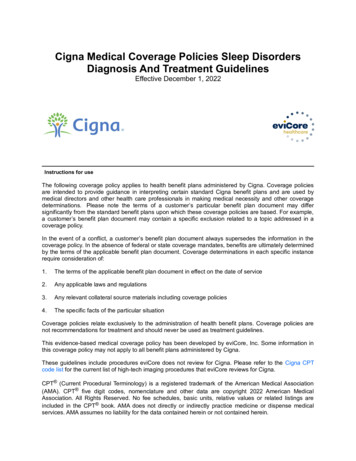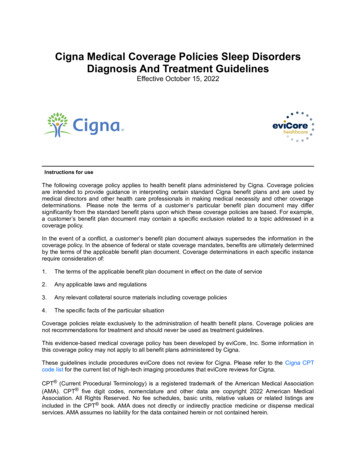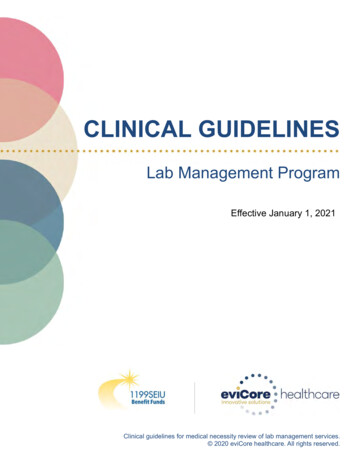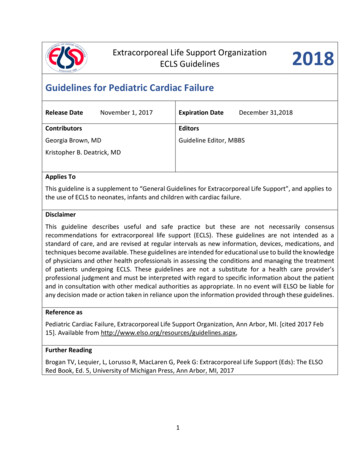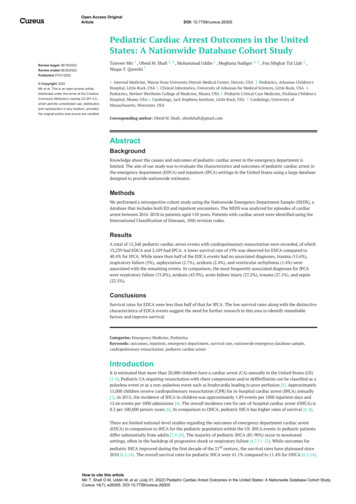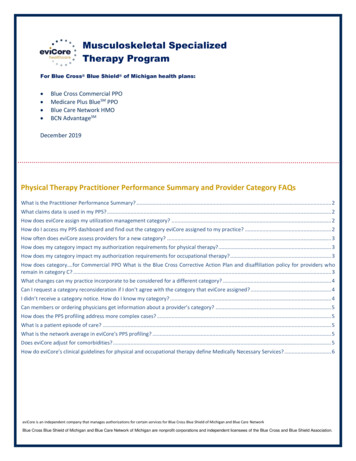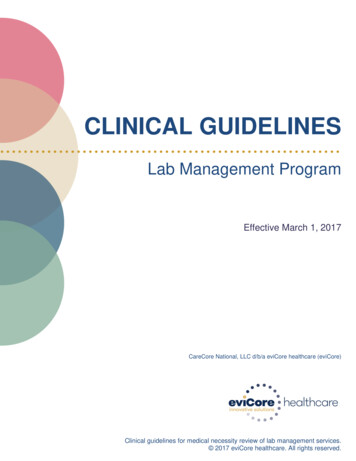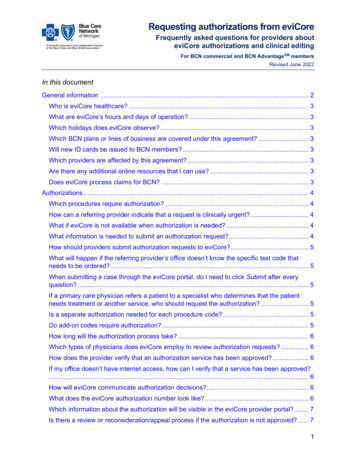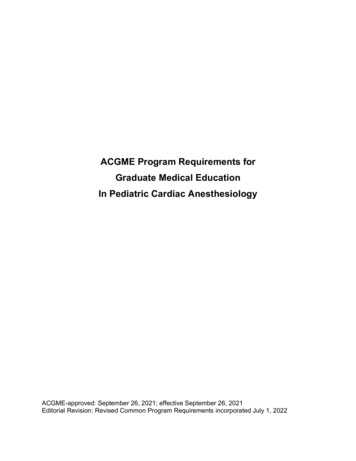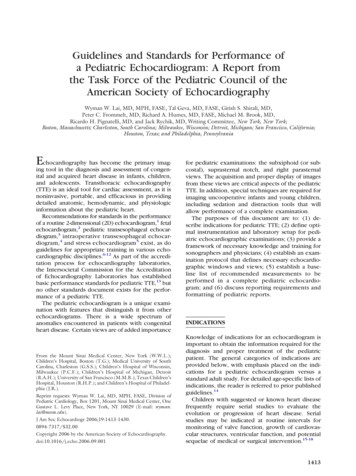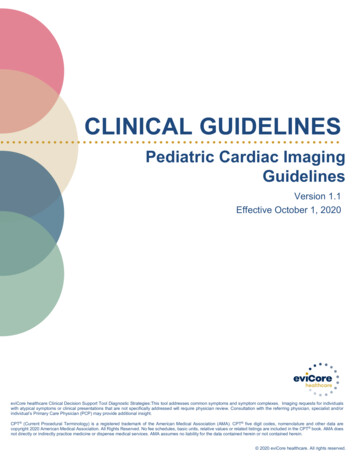
Transcription
CLINICAL GUIDELINESPediatric Cardiac ImagingGuidelinesVersion 1.1Effective October 1, 2020eviCore healthcare Clinical Decision Support Tool Diagnostic Strategies:This tool addresses common symptoms and symptom complexes. Imaging requests for individualswith atypical symptoms or clinical presentations that are not specifically addressed will require physician review. Consultation with the referring physician, specialist and/orindividual’s Primary Care Physician (PCP) may provide additional insight.CPT (Current Procedural Terminology) is a registered trademark of the American Medical Association (AMA). CPT five digit codes, nomenclature and other data arecopyright 2020 American Medical Association. All Rights Reserved. No fee schedules, basic units, relative values or related listings are included in the CPT book. AMA doesnot directly or indirectly practice medicine or dispense medical services. AMA assumes no liability for the data contained herein or not contained herein. 2020 eviCore healthcare. All rights reserved.
Pediatric Cardiac Imaging GuidelinesPediatric Cardiac Imaging GuidelinesPEDCD-1: General GuidelinesPEDCD-2: Congenital Heart DiseasePEDCD-3: Heart MurmurPEDCD-4: Chest PainPEDCD-5: SyncopePEDCD-6: Kawasaki DiseasePEDCD-7: Pediatric Pulmonary HypertensionPEDCD-8: Echocardiography – Other IndicationsPEDCD-9: Cardiac MRI – Other IndicationsPEDCD-10: CT Heart and Coronary Computed TomographyAngiography (CCTA) – Other IndicationsPEDCD-11: Cardiac CatheterizationProcedure Codes Associated with Cardiac or PVD ImagingV2.13914161922283136414649 2020 eviCore healthcare. All Rights Reserved.Page 2 of 54400 Buckwalter Place Boulevard, Bluffton, SC 29910 (800) 918-8924www.eviCore.com
Pediatric Cardiac Imaging GuidelinesV2.1PEDCD-1: General GuidelinesPEDCD-1.0: General Guidelines . 4PEDCD-1.1: Pediatric Cardiac Imaging Age Considerations. 4PEDCD-1.2: Pediatric Cardiac Imaging Appropriate ClinicalEvaluation . 4PEDCD-1.3: Pediatric Cardiac Imaging Modality GeneralConsiderations . 5 2020 eviCore healthcare. All Rights Reserved.Page 3 of 54400 Buckwalter Place Boulevard, Bluffton, SC 29910 (800) 918-8924www.eviCore.com
Pediatric Cardiac Imaging GuidelinesV2.1PEDCD-1.0: General Guidelines A recent (within 60 days) face-to-face evaluation should be performed prior toconsidering advanced imaging unless the patient is undergoing guideline-supportedscheduled follow-up imaging evaluation. This evaluation should include: A detailed history Physical examination Appropriate laboratory studies Advanced imaging of the heart should only be approved in patients who havedocumented active clinical signs or symptoms of disease involving the heart or asfollow-up for findings on echocardiograms. Unless otherwise stated in a specific guideline section, repeat imaging studies of theheart are not necessary unless: There is evidence for progression of disease New onset of disease and/or documentation of how repeat imaging will affectpatient management or treatment decisions.PEDCD-1.1: Pediatric Cardiac Imaging Age Considerations Heart disease in the pediatric population involves predominantly congenital lesions.Pediatric patients can have acquired heart disease unique to children. For thosediseases which occur in both pediatric and adult populations, differences exist inmanagement due to patient age, comorbidities, and differences in disease naturalhistory between children and adults. Individuals who are 18 years old should be imaged according to the PediatricCardiac Imaging Guidelines, and individuals who are age 18 years should beimaged according to the Cardiac Imaging Guidelines, except where directedotherwise by a specific guideline section. Patients for whom routine imaging is anticipated at the next visit (for example oneyear follow-up echo for a 10 year old with a VSD) may have these imaging studiesapproved without face to face evaluation if study was already indicated Unless otherwise stated in a specific guideline section, the use of advanced imagingto screen asymptomatic patients for disorders involving the heart is not supported. Patients starting ADHD medications, in the absence of other appropriate indicationslisted in these guidelines, imaging is not indicated. Asymptomatic Patients with known or suspected syndromes, which may beassociated with congenital heart disease, can have an initial echocardiogram. Asymptomatic patients with family history of aortopathy, cardiomyopathy, congenitalheart disease with known inheritance pattern, can have an echocardiogram as aninitial study. Additional studies are determined based on findings. 2020 eviCore healthcare. All Rights Reserved.Page 4 of 54400 Buckwalter Place Boulevard, Bluffton, SC 29910 (800) 918-8924www.eviCore.comPediatric Cardiac ImagingPEDCD-1.2: Pediatric Cardiac Imaging Appropriate Clinical Evaluation
Pediatric Cardiac Imaging GuidelinesV2.1 Asymptomatic patients with exposure to cardiotoxic drugs can have serialechocardiograms as per PEDONC-19.2: Cardiotoxicity and EchocardiographyPEDCD-1.3: Pediatric Cardiac Imaging Modality GeneralConsiderations MRI MRI and MRA studies are frequently indicated for evaluation of congenital heartdefects not well visualized on echocardiography, thoracic arteries and veins notvisualized on echocardiography, cardiomyopathies, and right ventricular disease,as well as in follow-up for these indications. Due to the length of time for image acquisition and the need for the patient to bemotionless during the acquisition , anesthesia is required for almost all infantsand young children (age 7 years), as well as older children with delays indevelopment or maturity. In this patient population, MRI imaging sessions shouldbe planned with a goal of avoiding a short-interval repeat anesthesia exposuredue to insufficient information using the following considerations: MRI is typically performed without and with contrast. If multiple body areas are supported by eviCore guidelines for the clinicalcondition being evaluated, MRI of all necessary body areas should beobtained concurrently in the same anesthesia session. Ultrasound Echocardiography is the primary modality used to evaluate the anatomy andfunction of the pediatric heart, and is generally indicated before considering otherimaging modalities. Coding considerations are listed in PEDCD-8: Echocardiography OtherIndications. Nuclear MedicineSPECT, PET stress may be indicated for patients with anomalous CA, angina chestpain, and follow-up for Kawasaki. See specific sections for those indications. Multi Gated Acquisition (MUGA) studies (CPT 78472, CPT 78473, CPT 78481,CPT 78483, CPT 78494, or CPT 78496) are rarely performed in pediatrics, butcan be approved for the following: Certain pediatric oncology patients when echocardiography is insufficient:See: PEDONC-1.2: Appropriate Clinical Evaluations for imagingguidelines. Quantitation of left ventricular function when recent echocardiogram showsejection fraction of 50% and MUGA results will impact acute patient caredecisions. 2020 eviCore healthcare. All Rights Reserved.Page 5 of 54400 Buckwalter Place Boulevard, Bluffton, SC 29910 (800) 918-8924www.eviCore.comPediatric Cardiac Imaging CT CT is primarily used to evaluate the coronary and great vessels in congenitalheart disease if cardiac MR is contraindicated. Coding considerations are listed in PEDCD-10: CT Heart and CoronaryComputed Tomography Angiography (CCTA) – Other Indications)
Pediatric Cardiac Imaging GuidelinesV2.1 SPECT/CT fusion imaging involves SPECT (MPI) imaging and CT for optimizinglocation, accuracy, and attenuation correction combines functional and anatomicinformation. There is currently no evidence-based data to formulate appropriatenesscriteria for SPECT/CT fusion imaging. Combined use of nuclear imaging, including SPECT, along with diagnostic CT(fused SPECT/CT) is considered investigational. Central C-V Hemodynamics (CPT 78414) is not an imaging study and is anoutdated examination Cardiac Shunt Detection (CPT 78428) is rarely performed in pediatrics but canbe approved for patients in whom Cardiac MR is not diagnostic Calculation of left and right ventricular ejection fractions Assessment of wall motion Quantitation of right to left shunts Myocardial Tc-99m Pyrophosphate Imaging Infarct Avid Myocardial Imaging studies (CPT 78466, CPT 78468, andCPT 78469), historically this method of imaging the myocardium ,Myocardial Tc-99m Pyrophosphate Imaging , was used to identify recentinfarction, hence, the term "infarct-avid scan.” Although still available, thesensitivity and specificity for identifying infarcted myocardial tissue is variableand the current use for this indication is limited CPT 78466, CPT 78468, and CPT 78469, CPT 78800 or CPT 78803may be used, for identification of myocardial ATTR (transthyretin)amyloidosis. Refer to CD-3.7: Myocardial Tc-99m Pyrophosphate Imagingand CD-3.8: Cardiac AmyloidosisCPT 7846678468784697880078803 The guidelines listed in this section for certain specific indications are not intended tobe all-inclusive; clinical judgment remains paramount and variance from theseguidelines may be appropriate and warranted for specific clinical situations. 2020 eviCore healthcare. All Rights Reserved.Page 6 of 54400 Buckwalter Place Boulevard, Bluffton, SC 29910 (800) 918-8924www.eviCore.comPediatric Cardiac ImagingMUGA (Multi Gated Acquisition) – Blood Pool ImagingMyocardial Imaging, infarct avid, planar, qualitative or quantitativeMyocardial Imaging, infarct avid, planar, qualitative or quantitative withejection fraction by first pass techniqueMyocardial Imaging, infarct avid, planar, qualitative or quantitativetomographic SPECT with or without quantificationRadiopharmaceutical Localization Imaging Limited areaRadiopharmaceutical Localization Imaging SPECTNote: When reporting CPT 78803, planar imaging of a limited area ormultiple areas should be included with the SPECT
Pediatric Cardiac Imaging GuidelinesV2.11. Karmazyn BK, John SD, Siegel MJ, et al. ACR–ASER–SCBT-MR–SPR Practice parameter for theperformance of pediatric computed tomography (CT). Am Coll Radiology (ACR). Revised 2014(Resolution 3). ameters/ct-ped.pdf?la en.2. Bridges MD, Berland LL, Kirby AB, et al. ACR Practice Parameter for performing and interpretingmagnetic resonance imaging (MRI). Am Coll Radiology (ACR). Revised 2017 (Resolution -Parameters/mr-perf-interpret.pdf?la en.3. Sorantin E and Heinzl B. What every radiologist should know about paediatric echocardiography. EurJ Radiol. 2014 Sep;83(9):1519-1528.4. Ing C, DiMaggio C, Whitehouse A, et al. Long-term differences in language and cognitive functionafter childhood exposure to anesthesia. Pediatrics. 2012 Aug;130(3):e476-e485.5. Monteleone M, Khandji A, Cappell J, et al. Anesthesia in children: perspectives from nonsurgicalpediatric specialists. J Neurosurg Anesthesiol, 2014 Oct 01;26(4):396-398.6. DiMaggio C, Sun LS, and Li G. Early childhood exposure to anesthesia and risk of developmentaland behavioral disorders in a sibling birth cohort. Anesth Analg, 2011 Nov;113(5):1143-1151.7. Moss AJ, Adams FH, Allen HD, et al. Moss and Adams' Heart Disease in Infants, Children, andAdolescents: Including the Fetus and Young Adult. Philadelphia: Wolters Kluwer; 20168. Lai WW, Geva T, Shirali GS, et al. Guidelines and Standards for Performance of a PediatricEchocardiogram: A Report from the Task Force of the Pediatric Council of the American Society ofEchocardiography. Journal of the American Society of Echocardiography. 01.9. Prakash A, Powell AJ, Geva T. Multimodality Noninvasive Imaging for Assessment of CongenitalHeart Disease. Circulation: Cardiovascular Imaging. 21.10. Doherty JU, Kort S, Mehran R, Schoenhagen P, et al.ACC/AATS/AHA/AYSE/ASNC/HRS/SCAI/SCCT/SCMR/STS 2017 Appropriate Use Criteria forMultimodality Imaging in Valvular Heart Disease. Journal of Nuclear Cardiology. 2017;24(6):20432063.11. Chowdhury D, Gurvitz M, Anderson J, et al. Development of Quality Metrics in Ambulatory PediatricCardiology. JACC: J Am Coll Cardiol. 2017 Feb, 69 (5) 541-555. doi: 10.1016/j.jacc.2016.11.043.12. Valente AM, Cook S, Festa P, et al. Multimodality Imaging Guidelines for Patients with RepairedTetralogy of Fallot: A Report from the American Society of Echocardiography. Journal of theAmerican Society of Echocardiography. 2014;27(2):111-141. doi:10.1016/j.echo.2013.11.009.13. Simpson J, Lopez L, Acar P, et al. Three-dimensional Echocardiography in Congenital Heart Disease:An Expert Consensus Document from the European Association of Cardiovascular Imaging and theAmerican Society of Echocardiography. Journal of the American Society of Echocardiography.2017;30(1):1-27. doi:10.1016/j.echo.2016.08.022.14. Cohen MS, Eidem BW, Cetta F, et al. Multimodality Imaging Guidelines of Patients with Transpositionof the Great Arteries: A Report from the American Society of Echocardiography Developedin Collaboration with the Society for Cardiovascular Magnetic Resonance and the Society ofCardiovascular Computed Tomography. Journal of the American Society of Echocardiography.2016;29(7):571-621. doi:10.1016/j.echo.2016.04.002.15. Silvestry FE, Cohen MS, Armsby LB, et al. Guidelines for the Echocardiographic Assessment of AtrialSeptal Defect and Patent Foramen Ovale: From the American Society of Echocardiography andSociety for Cardiac Angiography and Interventions. Journal of the American Society ofEchocardiography. 2015;28(8):910-958. doi:10.1016/j.echo.2015.05.015.16. Paridon SM. Clinical Stress Testing in the Pediatric Age Group: A Statement from the American HeartAssociation Council on Cardiovascular Disease in the Young, Committee on Atherosclerosis,Hypertension, and Obesity in Youth. Circulation. 106.17437D.17. Gidding SS, Champagne MA, Ferranti SDD, et al. The Agenda for Familial Hypercholesterolemia.Circulation. 2015;132(22):2167-2192. doi:10.1161/CIR.0000000000000297. 2020 eviCore healthcare. All Rights Reserved.Page 7 of 54400 Buckwalter Place Boulevard, Bluffton, SC 29910 (800) 918-8924www.eviCore.comPediatric Cardiac ImagingReferences
Pediatric Cardiac Imaging GuidelinesV2.1Pediatric Cardiac Imaging18. National Cancer Institute. Radiation Risks and Pediatric Computed Tomography. National CancerInstitute. ion/risk/radiation/pediatric-ct-scans.Published September 4, 2018. .19. Hundley WG, Bluemke DA, Finn JP, et al. ACCF/ACR/AHA/NASCI/SCMR 2010 Expert ConsensusDocument on Cardiovascular Magnetic Resonance. Circulation. 44a8f.20. Kane DA. Suspected heart disease in infants and children: Criteria for referral. forreferral. Published April 3, 2019. 2020 eviCore healthcare. All Rights Reserved.Page 8 of 54400 Buckwalter Place Boulevard, Bluffton, SC 29910 (800) 918-8924www.eviCore.com
Pediatric Cardiac Imaging GuidelinesPEDCD-2: Congenital Heart DiseasePEDCD-2.1: Congenital Heart Disease General ConsiderationsPEDCD-2.2: Congenital Heart Disease Echocardiography CodingPEDCD-2.3: Congenital Heart Disease Modality ConsiderationsPEDCD-2.4: Congenital Heart Disease Timing ConsiderationsV2.110101011 2020 eviCore healthcare. All Rights Reserved.Page 9 of 54400 Buckwalter Place Boulevard, Bluffton, SC 29910 (800) 918-8924www.eviCore.com
Pediatric Cardiac Imaging GuidelinesV2.1PEDCD-2.1: Congenital Heart Disease General Considerations Congenital heart disease accounts for the majority of cardiac problems occurring inthe pediatric population. Patients may be diagnosed any time spanning prenatalevaluation to adolescence. For patients over 18 year of age, see Adult CongenitalGuidelines. There are a number of variables that influence the modality and timing of imagingpatients with congenital heart disease, which results in a high degree of individualityin determining the schedule for imaging these patients, including: Gestational age Patient age Physiologic effects of the defect Status of interventions (catheterization and surgical) Rate of patient growth Stability of the defect on serial imaging Comorbid conditions Activity levelPEDCD-2.2: Congenital Heart Disease Echocardiography Coding Any of the following echocardiography code combinations are appropriate for reevaluation of patients with known congenital heart disease: CPT 93303, CPT 93320, and CPT 93325 CPT 93304, CPT 93321, and CPT 93325 CPT 93303 CPT 93304 CPT 93306 is not indicated in the evaluation of known congenital heart disease.PEDCD-2.3: Congenital Heart Disease Modality Considerations Echocardiography is the primary imaging modality used for diagnosing andmonitoring congenital heart disease and is generally required before other imagingmodalities are indicated unless otherwise indicated in a specific guideline section. Cardiac MRI either without contrast (CPT 75557) or without and with contrast(CPT 75561) is indicated, when a recent echocardiogram is inconclusive, needsconfirmation of findings, or does not completely define the disease (for subsequentfollow-up studies, a recent echocardiogram is not a requirement): CPT 75565 is also indicated for patients with valvular disease or a need toevaluate intracardiac blood flow. These patients will usually have CPT 93320and CPT 93325 performed with their echocardiography studies. MRA Chest (CPT 71555) may be added if the aorta or pulmonary artery needsto be visualized beyond the root, or if aortopulmonary collaterals, pulmonaryveins, or systemic veins need to be visualized. 2020 eviCore healthcare. All Rights Reserved.Page 10 of 54400 Buckwalter Place Boulevard, Bluffton, SC 29910 (800) 918-8924www.eviCore.comPediatric Cardiac Imaging All requested CPT combinations other than those listed in this section should beforwarded for Medical Director Review.
Pediatric Cardiac Imaging GuidelinesV2.1 MRA Chest alone (CPT 71555) should be performed if the patient cannotcooperate with full cardiac MRI exam. MRA Chest (CPT 71555) is assessment of the great arteries, pulmonary veins, andsystemic chest veins, including the following. Coarctation of the aorta, tetralogy of Fallot, anomalous pulmonary veins,Transposition of the great arteries, Truncus arteriosus, vascular rings, and otherlesions of the great arteries, with inconclusive recent echocardiography findings CT imaging is indicated, when recent echocardiogram is inconclusive, for thefollowing: Report CPT 75574 for evaluating coronary artery anomalies Report CPT 75573 for congenital heart disease CPT 71275 Determination of vascular extra-cardiac anatomy in patients withcomplex congenital heart disease Pulmonary artery (PA) and Pulmonary vein (PV) assessment CTA of the chest is indicated to assess, Coarctation of the aorta, tetralogy ofFallot, anomalous pulmonary veins, and other lesions of the great arteries,vascular rings, with inconclusive recent echocardiography findings Echocardiography is repeated frequently throughout a child’s life, and can generallybe approved regardless of symptoms according to the following schedule, with somemodifications listed below: Patients 0-2 months: Can have one repeat echocardiogram if prior echocardiogram is abnormal(either in hospital or as newborn outpatient) Patient’s age 0 to 2 years: every 3 months Patients with single ventricle physiology (e.g., Hypoplastic left heart syndrome[HLHS], Mitral atresia, Unbalanced atrioventricular septal defect [uAVSD])may require echocardiograms very frequently and can be approved: Birth to 6 months of life: every 2 weeks 7-12 months of life: 1 per month Then every 3 months until 2 years of age Patients with unrepaired asymptomatic isolated secundum atrial septal defect(ASD) without syndromes (such as Down Syndrome) or evidence ofpulmonary hypertension: Every 3 months until they are 1 year Then once a year, unless consideration for surgery Patient’s age 3 to 12 years: Non-ASD patients: every 6 months Patients with unrepaired asymptomatic isolated secundum atrial septal defect(ASD), without syndromes (such as Down Syndrome) or evidence ofpulmonary hypertension: Follow the above schedule until they are 1 year 2020 eviCore healthcare. All Rights Reserved.Page 11 of 54400 Buckwalter Place Boulevard, Bluffton, SC 29910 (800) 918-8924www.eviCore.comPediatric Cardiac ImagingPEDCD-2.4: Congenital Heart Disease Timing Considerations
Pediatric Cardiac Imaging GuidelinesV2.1Then they can have echocardiogram once a year, unless consideration forsurgery. Patient’s age 13 years and older: every 12 months Modifiers to the above schedule: Some congenital conditions may require more frequent testing, especiallywith more complex heart disease, congestive heart failure, obstructive heartlesions, ductal dependent lesions, changes in clinical status, repeatinterventions, and/or in neonates Any patient being treated for heart failure, with consideration for changingmedical regimen can have an echocardiogram Echocardiography is performed during the physician office visit, and these studiesshould not be denied because of lack of contact within 60 days1. Kliegman R, Lye PS, Bordini BJ, et al. Nelson Pediatric Symptom-Based Diagnosis. Philadelphia, PA:Elsevier; 2018.2. Riveros R and Riveros-Perez E. Perioperative considerations for children with right ventriculardysfunction. Seminars in Cardiothoracic and Vascular Anesthesia. 2015 Jul 10;19(3):187–202.3. Lai WW, Geva T, Shirali GS, et al. Guidelines and Standards for Performance of a PediatricEchocardiogram: A Report from the Task Force of the Pediatric Council of the American Society ofEchocardiography. Journal of the American Society of Echocardiography. ho.2006.09.001.4. Prakash A, Powell AJ, Geva T. Multimodality Noninvasive Imaging for Assessment of CongenitalHeart Disease. Circulation: Cardiovascular Imaging. ING.109.875021.5. Simpson J, Lopez L, Acar P, et al. Three-dimensional Echocardiography in Congenital Heart Disease:An Expert Consensus Document from the European Association of Cardiovascular Imaging and theAmerican Society of Echocardiography. Journal of the American Society of Echocardiography.2017;30(1):1-27. https://doi.org/10.1016/j.echo.2016.08.0226. Truong UT, Kutty S, Broberg CS, Sahn DJ. Multimodality Imaging in Congenital Heart Disease: anUpdate. Current Cardiovascular Imaging Reports. 2012;5(6):481-490. https://doi.org/10.1007/s12410012-9160-6.7. Wernovsky G, Rome JJ, Tabbutt S, et al. Guidelines for the Outpatient Management of ComplexCongenital Heart Disease. Congenital Heart Disease. 2006;1(1-2):10-26. .x.8. Altman CA. Identifying newborns with critical congenital heart disease. se/print.Published June 14, 2018.9. Valente AM, Cook S, Festa P, et al. Multimodality Imaging Guidelines for Patients with RepairedTetralogy of Fallot: A Report from the American Society of Echocardiography. Journal of theAmerican Society of Echocardiography. 2014;27(2):111-141. doi:10.1016/j.echo.2013.11.009.10. Margossian R, Schwartz ML, Prakash A, et al. Comparison of Echocardiographic and CardiacMagnetic Resonance Imaging Measurements of Functional Single Ventricular Volumes, Mass, andEjection Fraction (from the Pediatric Heart Network Fontan Cross-Sectional Study)††A list ofparticipating institutions and investigators appears in the Appendix. The American Journal ofCardiology. 2009;104(3):419-428. doi:10.1016/j.amjcard.2009.03.058.11. Hundley WG, Bluemke DA, Finn JP, et al. ACCF/ACR/AHA/NASCI/SCMR 2010 Expert ConsensusDocument on Cardiovascular Magnetic Resonance. Circulation. 44a8f. 2020 eviCore healthcare. All Rights Reserved.Page 12 of 54400 Buckwalter Place Boulevard, Bluffton, SC 29910 (800) 918-8924www.eviCore.comPediatric Cardiac ImagingReferences
Pediatric Cardiac Imaging GuidelinesV2.1Pediatric Cardiac Imaging12. Silvestry FE, Cohen MS, Armsby LB, et al. Guidelines for the Echocardiographic Assessment of AtrialSeptal Defect and Patent Foramen Ovale: From the American Society of Echocardiography andSociety for Cardiac Angiography and Interventions. Journal of the American Society ofEchocardiography. 2015;28(8):910-958. doi:10.1016/j.echo.2015.05.015.13. Franklin RCG, Béland MJ, Colan SD, et al. Nomenclature for congenital and paediatric cardiacdisease: the International Paediatric and Congenital Cardiac Code (IPCCC) and the EleventhIteration of the International Classification of Diseases (ICD-11). Cardiology in the Young.2017;27(10):1872-1938. doi:10.1017/s1047951117002244.14. Cohen MS, Eidem BW, Cetta F, et al. Multimodality Imaging Guidelines of Patients with Transpositionof the Great Arteries: A Report from the American Society of Echocardiography Developedin Collaboration with the Society for Cardiovascular Magnetic Resonance and the Society ofCardiovascular Computed Tomography. Journal of the American Society of Echocardiography.2016;29(7):571-621. doi:10.1016/j.echo.2016.04.002.15. Canobbio MM, Warnes CA, Aboulhosn J, et al. Management of Pregnancy in Patients With ComplexCongenital Heart Disease: A Scientific Statement for Healthcare Professionals From the AmericanHeart Association. Circulation. 2017;135(8). doi:10.1161/cir.0000000000000458.16. Hare GFV, Ackerman MJ, Evangelista J-AK, et al. Eligibility and Disqualification Recommendationsfor Competitive Athletes With Cardiovascular Abnormalities: Task Force 4: Congenital Heart Disease.Journal of the American College of Cardiology. 36.17. Giglia T, Stagg A. Infant Single Ventricle Monitoring Program (ISVMP): Outpatient InterstagePathway: Stage I Discharge to Second Operation. Clinical Pathways Program ricle-fetus-or-newborn-clinical-pathway. PublishedJuly 2011. Accessed July 26, 2019. Revised January 2018 2020 eviCore healthcare. All Rights Reserved.Page 13 of 54400 Buckwalter Place Boulevard, Bluffton, SC 29910 (800) 918-8924www.eviCore.com
Pediatric Cardiac Imaging GuidelinesPEDCD-3: Heart MurmurPEDCD-3.1: Heart Murmur GeneralV2.115 2020 eviCore healthcare. All Rights Reserved.Page 14 of 54400 Buckwalter Place Boulevard, Bluffton, SC 29910 (800) 918-8924www.eviCore.com
Pediatric Cardiac Imaging GuidelinesV2.1PEDCD-3.1: Heart Murmur General Heart murmurs are extremely common in pediatric patients. The thinner chest wall inchildren allows clearer auscultation of blood flowing through the chambers of theheart, which may result in a murmur on physical exam. The majority of murmurs are innocent and do not require further evaluation. Morethan 30% of children may have an innocent murmur detected during physicalexamination. Innocent murmurs are typically systolic ejection murmurs with avibratory or musical quality, and generally change in quality when the patientchanges position. Other types of murmurs can be pathologic and require additional evaluation, usuallyby a pediatric cardiologist. Echocardiography is indicated, and is performed as partof the office visit. When evaluating a patient with a murmur for the first time, it will notbe known whether the patient has congenital heart disease or not. The cardiologistonly submits charges for the procedure actually performed. The following echocardiography code combinations should be approved forevaluation of any pathologic murmur or any innocent murmur with associatedcardiac signs or symptoms: CPT 93303, CPT 93306, CPT 93320, and CPT 93325 CPT 93303, CPT 93306 CPT 93306, CPT 93320 and CPT 93325 are included with CPT 93306 andshould not be approved separately. Repeat echocardiography is not indicated if the initial echocardiogram was normaland the murmur has not changed in quality. 2020 eviCore healthcare. All Rights Reserved.Page 15 of 54400 Buckwalter Place Boulevard, Bluffton, SC 29910 (800) 918-8924www.eviCore.comPediatric Cardiac ImagingReferences1. Nelson Textbook of Pediatrics, 20th Edition, Robert M. Kliegman, MD, Bonita M.D. Stanton, MD,Joseph St. Geme, MD and Nina F Schor, MD, PhD, p2182 to p2292.2. Campbell RM, Douglas PS, Eidem BW, Lai WW, Lopez L, Sachdeva R.ACC/AAP/AHA/ASE/HRS/SCAI/SCCT/SCMR/SOPE 2014 Appropriate Use Criteria for InitialTransthoracic Echocardiography in Outpatient Pediatric Cardiology. Journal of the American Collegeof Cardiology. 2014;64(19):2039-2060. doi:10.1016/j.jacc.2014.08.003.3. Lai WW, Geva T, Shirali GS, et al. Guidelines and Standards for Performance of a PediatricEchocardiogram: A Report from the Task Force of the Pediatric Council of the American Society ofEchocardiography. Journal of the American Society of Echocardiography. 01.4. Allen HD, Shaddy RE, Penny DJ, Cetta F, Feltes TF. Moss and Adams' Heart Disease in Infants,Children, and Adolescents: Including the Fetus and Young Adult. 9th ed. Philadelphia, PA: WoltersKluwer; 2016.5. Prakash A, Powell AJ, Geva T. Multimodality Noninvasive Imaging for Assessment of CongenitalHeart Disease. Circulation: Cardiovascular Imaging. 21.6. Geg
Pediatric Cardiac Imaging Asymptomatic patients with exposure to cardiotoxic drugs can have serial echocardiograms as per PEDONC-19.2: Cardiotoxicity and Echocardiography PEDCD-1.3: Pediatric Cardiac Imaging Modality General Considerations MRI MRI and MRA studies are frequently indicated for evaluation of congenital heart
